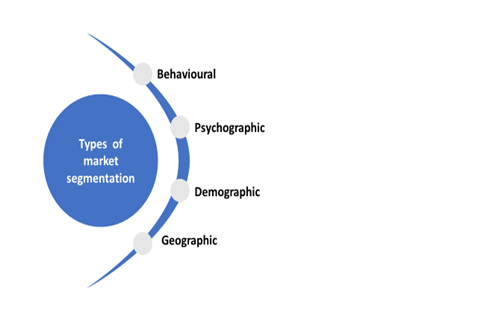What is meant by market segment?
Segmentation is categorising a large unit into multiple smaller units based on some common characteristic features. In the field of marketing, market segmentation is the concept of dividing the entire market into smaller groups or segments on the basis of consumer preferences, geography, behaviour, demography, income, personality traits.
Summary
- Market segmentation is dividing the entire market into smaller groups or segments based on consumer preferences, geography, behaviour, demography, income, personality traits.
- Market segmentation can be done based on demography, behaviour, geography, psychology etc.
- Knowledge on market segments helps in in decision making regarding designing and launching new or updating the existing products.
Frequently Asked Questions (FAQs)
What is the importance of market segmentation?
Dividing markets into segments helps in the process of making the right business decisions. Knowledge of new unexplored markets could mean a competitive advantage in the market sector. Similarly, it becomes easier to widen the consumer base. Proper knowledge of the market segments is essential while designing new products, launching new services or updating the existing products. Specialised products always give an edge in the industry, and specialisation is possible when there is clear knowledge of what the respective segment wants. Advertising and other media campaigns also tend to succeed better when there is a direction in which it is targeted.
What are the main types of market segmentation?
Few types of market segmentation are as shown below:-

Copyright © 2021 Kalkine Media
Behavioural Segmentation
The process of segmenting a market based on behavioural characteristics of consumers/markets such as the frequency with which they use a particular product, their loyalty to a particular brand, the benefits required at any given time, and their behaviour or attitude toward purchasing/buying a product/service. The ability to cater to customers' needs based on their behavioural patterns contributes to the brand's market loyalty. Behavioural segmentation is market research focused on the behavioural qualities or attitudes of customers or markets – the consumer's likes and dislikes concerning certain products/services, brand interest, purchase habit, and cost sensitivity.
Psychographic Segmentation
Psychographics is a sort of client segmentation that focuses on qualitative or inner characteristics. Psychographic elements aren't visible merely by glancing at your customer. On the other hand, psychographics necessitates a more thorough examination to understand habits, hobbies, pastimes, or passions, opinions or values, personality or outlook on life, and social standing of the customers. This is useful for personalising products.

Image source © Hobbitfoot | Megapixl.com
Demographic segmentation
Demographic segments are bifurcations made based on age, gender, income, stage of the life cycle, religion or nationality. It is considered one of the best measures for mass marketing. All these factors are decisive factors when trying to gauge what a consumer’s demand is. For example, age is an essential factor because a young customer may want a hi-tech cell phone, while a retired person may need only basic features that can help them stay connected and communicate. Similarly, the choice of insurance policies is taken by individuals depending on their life cycle stage. Even in the market for accessories, the product and marketing strategies differ depending on the gender of the target consumer. Likewise, a Ferrari is meant for ultra-rich customers. Similarly, the choice of products depends on the social systems like religious beliefs too- the public will not accept a beef burger at McDonald's in the Indian markets.
Geographic segmentation
Geographic segmentation is the study of a customer's geographical location. Consumers in similar geographic areas may have similar preferences. As a result, this sort of market segmentation pairs well with more abstract types like behavioural. Understanding client groups' climates and geographic regions can assist in deciding where to supply and advertise, as well as expansion prospects.
What is the process of market segmentation?
There are five main steps in segmentation and they are as follows:-
- To understand the customers better, it is essential to conduct preliminary research. This can be done in ways like administering questionnaires, surveys, feedback forms etc. Some consumers may even be interviewed for this purpose. The end goal of this activity should be to understand consumer preferences, likes and dislikes better.
- It is essential to decide a criterion for segmenting the market. For example, segmentation can be done based on age or income group or behaviour.
- The study must be designed such that it can capture multiple questions. It is also essential that responses are quantifiable.
- Based on the analysis of the responses received, customers must be grouped into segments.
- Once the segmentation is done, it is essential to make sure that the segmentation is useful. This could be done by running a pilot and checking the change in sales, change in consumer feedback or any other relevant parameter.
How do we know that the segmentation is effective?
Assessing the effectiveness of the segments created is of utmost essence to perform better in the market. Therefore, the variables to study segmentation must directly link to the commodity in question- it should be associated with the purchase decision for the commodity. For example, one could study which age group is more attracted to buy when there is a sale.
The segmentation process becomes effective when the services offered are also tweaked to meet the requirements of the respective category. For example, a flash sale may not be the best idea when targeting retired customers in a developing nation. This is because their knowledge and exposure to technology may be less, and hence their speed to grab offers on a flash may also be squinted. Similarly, if segmentation was done based on income category, it is also essential to have products of varied pricing affordable by people of all categories. Customers must want to purchase the commodity being offered otherwise, segmentation expense could be a cost without proportional returns.
However, market segmentation is not an exact science. There is trial and error, learning by doing and other forms of practical exposure required to make the process effective.
 CA
CA  AU
AU UK
UK US
US NZ
NZ Please wait processing your request...
Please wait processing your request...